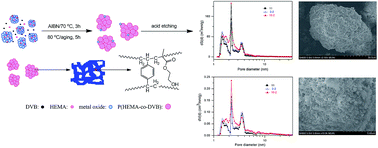Metal oxide as a template in the preparation of porous poly(2-hydroxyethylmethylacrylate-co-divinylbenzene) particles as a metallocene catalyst support†
Abstract
Porous organic polymers (POPs) are a kind of carrier and support material which could be used in the fields of absorption, separation and catalysis. In this paper, poly(2-hydroxyethylmethylacrylate-co-divinylbenzene) [P(HEMA-co-DVB)] particles were prepared by using metal oxide as a particle-forming template. The effects of Fe3O4/monomer mass ratio, sonification of Fe3O4 nano-bead aggregates, and other types of metal oxide template were investigated. The results showed that the metal oxide could be a good particle-forming template for obtaining a suitable particle morphology and pore structure of the P(HEMA-co-DVB). A shift of pore size distribution to the right or increase of pore size abundance of the prepared P(HEMA-co-DVB) particles was observed when increasing the Fe3O4/monomer ratio from 0 to 7%, and the specific surface area (SSA) and the total pore volume (PV) of the prepared P(HEMA-co-DVB) particles increased dramatically with 248 g m−2 of SSA and 0.394 g ml−1 of PV, when 1.5 wt% Fe3O4/monomer was added. The SSA and PV of the final P(HEMA-co-DVB) also increased dramatically after sonification of the Fe3O4 nano-bead aggregates, however, the bulk density of the support decreased. Larger PV (0.488 cm3 g−1) and average pore diameter (12.1 nm) of the prepared P(HEMA-co-DVB) particles were obtained with a relatively high HEMA content. This provides a feasible route to prepare functional PDVB particles with controllable pore structure and particle morphology. In the ethylene homopolymerization evaluation of supported metallocene catalysts, these nanoporous polymeric supports show better catalytic activity compared to the conventional silica support. The availability of such porous polymer supports is expected to stimulate further studies of these materials in polymer synthesis technologies and polyolefin catalysis applications.


 Please wait while we load your content...
Please wait while we load your content...